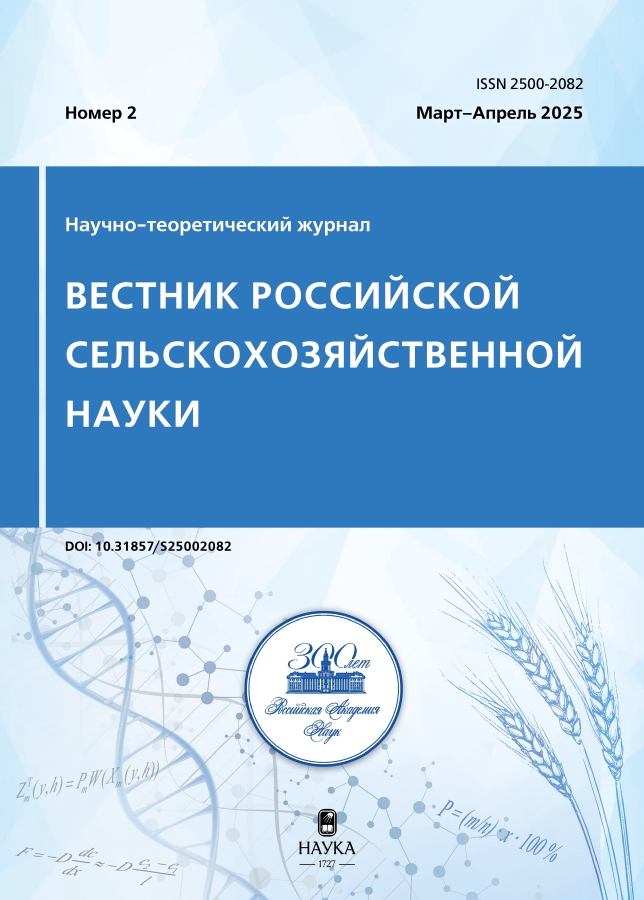Researching of the drought resistance of the Far East selection barley spring varieties
- 作者: Sinegovskaya V.T.1, Trifuntova I.B.1, Sinegovsky M.O.1
-
隶属关系:
- Federal State Budgetary Institution of Science Khabarovsk Federal Research Center of the Far Eastern Branch of the Russian Academy of Sciences Far Eastern Agricultural Research Institute
- 期: 编号 2 (2025)
- 页面: 4-7
- 栏目: Crop Production and Selection
- URL: https://vietnamjournal.ru/2500-2082/article/view/684938
- DOI: https://doi.org/10.31857/S2500208225020012
- EDN: https://elibrary.ru/HTRWKD
- ID: 684938
如何引用文章
详细
The article presents the results of studying spring oat varieties bred at the Far Eastern Research Institute of Agriculture for drought resistance under laboratory conditions to determine seed sowing qualities under changing osmotic pressure and in soil and climatic conditions of the south of Khabarovsk region. In laboratory experiments, with an increase in the osmotic pressure of sucrose from 6 to 9 atm, seed germination in the Peredovik variety decreased by 14.7 percentage points, and in the Dalnevostochny Zolotoy variety by only 8.5. The proportion of germinated seeds in the Dalnevostochny Zolotoy variety at 6 atm was higher by 9.4 percentage points, and at 9 atm – by 15.6 percentage points compared to this indicator for the Peredovik variety. The advantage of the Dalnevostochny Zolotoy variety in reducing growth processes was revealed compared to this indicator for the Peredovik variety. In field conditions with a lack of moisture in July, when the amount of precipitation was 61 mm less than the norm, the Peredovik variety plants were 19.8 cm lower in height than the Dalnevostochny Zolotoy variety, and 3.4 g lower in 1000-grain weight, which is due to the variety’s response to the lack of moisture in the soil and the increased temperature regime during this period. As a result, the grain productivity per plant of the Peredovik variety was 2 g lower than that of the Dalnevostochny Zolotoy variety. A correlative relationship was found between productive tillering of oat varieties with the 1000 grain weight and grain productivity per plant. It was highest for the Peredovik variety (r = 0.89), while for the Dalnevostochny Zolotoy variety this dependence was average (r = 0.63). According to the research results, the spring oat variety Dalnevostochny Zolotoy showed greater resistance to drought compared to the Peredovik variety, which allows us to recommend it for inclusion in the selection process as a source of resistance to this factor.
全文:
作者简介
Valentina Sinegovskaya
Federal State Budgetary Institution of Science Khabarovsk Federal Research Center of the Far Eastern Branch of the Russian Academy of Sciences Far Eastern Agricultural Research Institute
编辑信件的主要联系方式.
Email: valsin09@gmail.com
Academician of the RAS, Professor, Honored Scientist of the Russian Federation
俄罗斯联邦, Vostochnoye village, Khabarovsk TerritoryIrina Trifuntova
Federal State Budgetary Institution of Science Khabarovsk Federal Research Center of the Far Eastern Branch of the Russian Academy of Sciences Far Eastern Agricultural Research Institute
Email: valsin09@gmail.com
PhD in Agricultural Sciences
俄罗斯联邦, Vostochnoye village, Khabarovsk TerritoryMikhail Sinegovsky
Federal State Budgetary Institution of Science Khabarovsk Federal Research Center of the Far Eastern Branch of the Russian Academy of Sciences Far Eastern Agricultural Research Institute
Email: valsin09@gmail.com
PhD in Economic Sciences
俄罗斯联邦, Vostochnoye village, Khabarovsk Territory参考
- Aseeva T.A., Trifuntova I.B. Adaptivnaya reakciya sortov i selekcionnyh linij yarovogo ovsa v usloviyah Srednego Priamur'ya // Dostizheniya nauki i tekhniki APK. 2022. T. 36. № 4. S. 22–28. https://doi.org/10.53859/02352451_2022_36_4_22
- Batalova G.A. Nekotorye aspekty ustojchivosti k limitiruyushchim faktoram v selekcii ovsa // Zernobobovye i krupyanye kul'tury. 2013. № 2 (6). S. 52–58.
- Dospekhov B.A. Metodika polevogo opyta (s osnovami statisticheskoj obrabotki rezul'tatov issledovanij). 5-e izd., dop. i pererab. M.: Agropromizdat, 1985. 207 s.
- Koshkin E.I. Fiziologiya ustojchivosti sel'skohozyajstvennyh kul'tur: uchebnik. M.: Drofa, 2010. 638 s.
- Lyubimova A.V., Mamaeva V.S., Menshchikova A.A. Geneticheskaya zasuhoustojchivost' sovremennyh sortov ovsa posevnogo kak otvet global'nomu izmeneniyu klimata // Agrarnyj vestnik Urala. 2022. № 06 (221). S. 49–59. https://doi.org/10.32417/1997-4868-2022-221-06-49-59
- Metodika gosudarstvennogo sortoispytaniya sel'skohozyajstvennyh kul'tur: zernovye, krupyanye, zernobobovye, kukuruza i kormovye kul'tury / red. V.I. Golovachev, E.V. Kirilovskaya. M.: Kalininskaya oblastnaya tipografiya, 1989. Vyp. 2. 195 s.
- Petunkina L.O., Svirkova S.V., Maevskaya N.A., Starcev A.A. Fiziologicheskaya ocenka ustojchivosti ovsa. Vestnik KemGU. 2012. № 4 (52). T. 1. S. 20–24.
- Sychev V.G., Osipova L.V., Kurnosova T.L. Patent № 2651284. Publ. 19.04.2018.
补充文件










